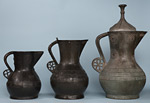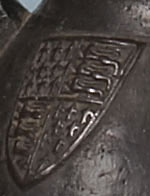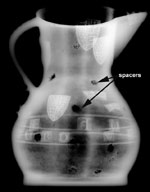items » Asante ewer
Asante ewer
The Asante ewer (British Museum 1896,7-27,1) is a very large metal jug, 43 cm high without its lid and weighing 18.6 kg when empty, with a capacity of 15.8 litres. The recent reappearance of another large metal jug, known today as the Wenlok jug, because it bears the inscription 'MY LORD WENLOK', brings the number of these great medieval English metal jugs known today to three (see the photograph below). The middle size jug is in the collections of the Victoria & Albert Museum (V&A 217-1879). The smallest, the Wenlok jug, has recently been acquired by Luton Museum.

Three jugs, copper alloy. From left to right: The Wenlok jug (Luton Museum, Wardown Park); The Robinson jug (Victoria and Albert Museum); The Asante ewer (British Museum)
Larger image (26KB)
The Asante ewer has a lid. The others have the remains of hinges on the rim where their lids were once attached. The Asante ewer is different in colour and detail to the other jugs, but although the three differ in size and capacity, they have obvious similarities in shape. The inscriptions are in English, not Latin. All three inscriptions are different, but the letters are very similar. All bear crown motifs and the English Royal arms as they were used between 1340 and the earlier years of the reign of Henry IV. What is the connection, if any, between them? All three were brought together for study at the British Museum science laboratory to try to answer this question.

Detail of the Wenlok jug showing the English royal arms
The results of scientific examination show close similarities between the jugs in materials and construction. X-ray fluorescence analysis established that all three are made of leaded bronze, an alloy of copper, tin and lead (see the British Museum website for an explanation of X-ray fluorescence). This is not uncommon, but significantly the impurities in the metal are similar in all three.

Radiographic image of the Wenlock jug showing spacers
They were all cast by pouring molten bronze into two-part moulds. Again this was standard practice, but radiography revealed features that link the jugs together more closely, perhaps to the same foundry. There are distinctive bronze spacers positioned inside the mould to keep open the gap for the metal to flow between the outer casing of the mould and the inner wall (core). At least fourteen of these spacers are preserved in the metal walls of each jug, where the molten bronze solidified around them. They show as dark, square patches in the radiographs of all three jugs. Thicker areas of metal, such as the lettering and the coats of arms appear pale in the radiograph. The spacers are dark because they are full of bubbles, so they are less dense than the bronze of the jug. This unusual feature is the same for all three jugs.
S. La N.
Ewers are listed on membranes 7–13 of the treasure roll.

